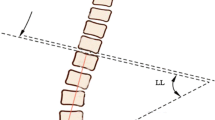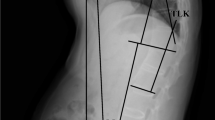Abstract
Study design
Retrospective multi-center cohort study.
Purpose
Sagittal misalignment causes changes in the abdominal shape. Xipho-pubic angle (XPA) has been previously described to radiographically evaluate the shape of the abdominal cavity in patients with spine deformity. The aims of this study are to evaluate the correlation of XPA-to-spinopelvic sagittal parameters and to patients’ health-related quality-of-life (HRQoL) scores.
Methods
278 patients from a multi-center database with diagnosis adult spinal deformity (ASD) (one or more of: coronal Cobb angle > 20°, sagittal vertical axis (SVA) > 50 mm, pelvic tilt (PT) > 25°, and thoracic kyphosis > 60°) were included. Cut-off values for moderate and severe disability (ODI—Oswestry Disability Index—20 and 40%) were calculated. Pearson’s correlation was tested between XPA and spinopelvic parameters and between XPA and HRQoL scores.
Results
The cut-off value of XPA to identify ODI severe disability (40/100) was identified with XPA smaller than 103°; minimal (20/100) disability was identified by XPA greater than 113°. XPA showed strong correlation to sagittal spinopelvic parameters—PT, SVA, lumbar lordosis (LL), pelvic incidence (PI) minus LL—and to HRQoL scores—ODI, SF-36 PCS and SRS-22 activity and pain. XPA was the parameter with the strongest correlation to HRQoL scores.
Conclusions
Xipho-pubic angle reflects changes in spinal changes and has strong correlation to HRQoL and spinopelvic parameters. It can discriminate between patients with minimal, moderate, and severe disability as measured by ODI scores.
Graphical Abstract
These slides can be retrieved under Electronic Supplementary Material.


Similar content being viewed by others
References
Dubousset J (1994) Three-dimensional analysis of the scoliotic deformity. Pediatr Spine 1994:479–496
Bess S, Line B, Fu KM et al (2016) The health impact of symptomatic adult spinal deformity: comparison of deformity types to United States population norms and chronic diseases. Spine (Phila Pa 1976) 41:224–233. https://doi.org/10.1097/brs.0000000000001202
Schwab F, Dubey A, Gamez L et al (2005) Adult scoliosis: prevalence, SF-36, and nutritional parameters in an elderly volunteer population. Spine (Phila Pa 1976) 30:1082–1085. https://doi.org/10.1097/01.brs.0000160842.43482.cd
Schwab F, Ungar B, Blondel B et al (2012) Scoliosis Research Society-Schwab adult spinal deformity classification: a validation study. Spine (Phila Pa 1976) 37:1077–1082. https://doi.org/10.1097/brs.0b013e31823e15e2
Lafage V, Schwab F, Patel A et al (2009) Pelvic tilt and truncal inclination: two key radiographic parameters in the setting of adults with spinal deformity. Spine (Phila Pa 1976) 34:E599–E606. https://doi.org/10.1097/brs.0b013e3181aad219
Garbossa D, Pejrona M, Damilano M et al (2014) Pelvic parameters and global spine balance for spine degenerative disease: The importance of containing for the well being of content. Eur Spine J 23:S616–S627. https://doi.org/10.1007/s00586-014-3558-6
Lamartina C, Berjano P (2014) Classification of sagittal imbalance based on spinal alignment and compensatory mechanisms. Eur Spine J 23:1177–1189. https://doi.org/10.1007/s00586-014-3227-9
Berjano P, Langella F, Damilano M et al (2015) Fusion rate following extreme lateral lumbar interbody fusion. Eur Spine J 24(Suppl 3):369–371. https://doi.org/10.1007/s00586-015-3929-7
Kim KT, Suk KS, Cho YJ et al (2002) Clinical outcome results of pedicle subtraction osteotomy in ankylosing spondylitis with kyphotic deformity. Spine (Phila Pa 1976) 27:612–618. https://doi.org/10.1097/00007632-200203150-00010
Diebo BG, Henry J, Lafage V, Berjano P (2015) Sagittal deformities of the spine: factors influencing the outcomes and complications. Eur Spine J 24(Suppl 1):3–15. https://doi.org/10.1007/s00586-014-3653-8
Liu C, Zheng G, Zhang Y et al (2015) The radiologic, clinical results and digestive function improvement in patients with ankylosing spondylitis kyphosis after pedicle subtraction osteotomy. Spine J 15:1988–1993. https://doi.org/10.1016/j.spinee.2015.04.030
Langella F, Villafañe JH, Ismael M et al (2015) Reliability of the xipho-pubic angle in patients with sagittal imbalance of the spine. J Neurosurg Sci (Epub ahead of print)
Grevitt M, Khazim R, Webb J et al (1997) The short form-36 health survey questionnaire in spine surgery. J Bone Joint Surg Br 79:48–52. https://doi.org/10.1302/0301-620X.79B1.1269
Fairbank JC, Pynsent PB (2000) The Oswestry Disability Index. Spine (Phila Pa 1976) 25:2940–2952. https://doi.org/10.1097/00007632-200011150-00017 (discussion 2952)
Bridwell KH, Berven S, Glassman SD et al (2007) Is the SRS-22 instrument responsive to change in adult scoliosis patients having primary spinal deformity surgery? Spine (Phila Pa 1976) 32:2220–2225. https://doi.org/10.1097/brs.0b013e31814cf120
Rillardon L, Levassor N, Guigui P et al (2003) Validation of a tool to measure pelvic and spinal parameters of sagittal balance. Rev Chir orthop{é}dique r{é}paratrice l’appareil Mot 89:218–227
Benoist M (2003) Natural history of the aging spine. Eur Spine J 12:86–90. https://doi.org/10.1007/s00586-003-0593-0
Glassman SD, Bridwell K, Dimar JR et al (2005) The impact of positive sagittal balance in adult spinal deformity. Spine (Phila Pa 1976) 30:2024–2029. https://doi.org/10.1097/01.brs.0000179086.30449.96
Lafage R, Schwab F, Challier V et al (2016) Defining Spino-Pelvic Alignment Thresholds. Spine (Phila Pa 1976) 41:62–68. https://doi.org/10.1097/brs.0000000000001171
Berjano P, Langella F, Ismael M-F et al (2014) Successful correction of sagittal imbalance can be calculated on the basis of pelvic incidence and age. Eur Spine J 23(Suppl 6):587–596. https://doi.org/10.1007/s00586-014-3556-8
Protopsaltis TS, Schwab FJ, Bronsard N et al (2014) The t1 pelvic angle, a novel radiographic measure of global sagittal deformity, accounts for both spinal inclination and pelvic tilt and correlates with health-related quality of life. J Bone Joint Surg Am 96:1631–1640. https://doi.org/10.2106/JBJS.M.01459
Smith JS, Klineberg E, Schwab F et al (2013) Change in classification grade by the SRS-Schwab adult spinal deformity classification predicts impact on health-related quality of life measures. Spine (Phila Pa 1976) 38:1663–1671. https://doi.org/10.1097/brs.0b013e31829ec563
Ji ML, Qian BP, Qiu Y et al (2015) Change in abdominal morphology after surgical correction of thoracolumbar kyphosis secondary to ankylosing spondylitis: a computed tomographic study. Spine (Phila Pa 1976) 40:E1244–E1249. https://doi.org/10.1097/brs.0000000000001112
Ji M, Qian B, Qiu Y et al (2013) Change of aortic length after closing-opening wedge osteotomy for patients with ankylosing spondylitis with thoracolumbar kyphosis. Spine (Phila Pa 1976) 38:E1361–E1367. https://doi.org/10.1097/brs.0b013e3182a3d046
Krishnakumar R, Lenke LG (2015) “Sternum-Into-Abdomen” deformity with abdominal compression following osteoporotic vertebral compression fractures managed By 2-level vertebral column resection and reconstruction. Spine (Phila Pa 1976) 40:E1035–E1039. https://doi.org/10.1097/brs.0000000000001004
Ryan DJ, Protopsaltis TS, Ames CP et al (2014) T1 pelvic angle (TPA) effectively evaluates sagittal deformity and assesses radiographical surgical outcomes longitudinally. Spine (Phila Pa 1976) 39:1203–1210. https://doi.org/10.1097/brs.0000000000000382
Johnston CE, Richards BS, Sucato DJ et al (2011) Correlation of preoperative deformity magnitude and pulmonary function tests in adolescent idiopathic scoliosis. Spine (Phila Pa 1976) 36:1096–1102. https://doi.org/10.1097/brs.0b013e3181f8c931
Bongiovanni R, Spradley MK (2012) Estimating sex of the human skeleton based on metrics of the sternum. Forensic Sci Int 219:290-e1. https://doi.org/10.1016/j.forsciint.2011.11.034
Author information
Authors and Affiliations
Corresponding author
Ethics declarations
Conflict of interest
On behalf of all authors, the corresponding author states that there is no conflict of interest.
Electronic supplementary material
Below is the link to the electronic supplementary material.
Rights and permissions
About this article
Cite this article
Langella, F., Villafañe, J.H., Lafage, V. et al. Xipho-pubic angle (XPA) correlates with patient’s reported outcomes in a population of adult spinal deformity: results from a multi-center cohort study. Eur Spine J 27, 670–677 (2018). https://doi.org/10.1007/s00586-017-5460-5
Received:
Revised:
Accepted:
Published:
Issue Date:
DOI: https://doi.org/10.1007/s00586-017-5460-5




